
Leduc is a city in the province of Alberta, Canada. It is 33 km (21 mi) south of the provincial capital of Edmonton and is part of the Edmonton Metropolitan Region.
Alberta Provincial Highway No. 2, commonly referred to as Highway 2 or the Queen Elizabeth II Highway, is a major highway in Alberta that stretches from the Canada–United States border through Calgary and Edmonton to Grande Prairie. Running primarily north to south for approximately 1,273 kilometres (791 mi), it is the longest and busiest highway in the province carrying more than 170,000 vehicles per day near Downtown Calgary. The Fort Macleod—Edmonton section forms a portion of the CANAMEX Corridor that links Alaska to Mexico. More than half of Alberta's 4 million residents live in the Calgary–Edmonton Corridor created by Highway 2.

Leduc County is a municipal district in Alberta, Canada that is immediately south of the City of Edmonton. It spans 105 km (65 mi) east to west and 32 km (20 mi) north to south, and has a population of 14,416. The municipal district is home to prairie parkland and several lakes and is home to the Edmonton International Airport, the Nisku Industrial Business Park and the Genesee Generating Station.
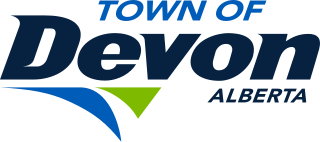
Devon is a town in the Edmonton Metropolitan Region of Alberta, Canada. It is approximately 26 km (16 mi) southwest of Edmonton, the provincial capital, along the southern bank of the North Saskatchewan River.

Beaumont is a city in Leduc County within the Edmonton Metropolitan Region of Alberta, Canada. It is located at the intersection of Highway 625 and Highway 814, adjacent to the City of Edmonton and 6.0 kilometres (3.7 mi) northeast of the City of Leduc. The Nisku Industrial Park and the Edmonton International Airport are located 4.0 kilometres (2.5 mi) to the west and 8.0 kilometres (5.0 mi) to the southwest respectively.
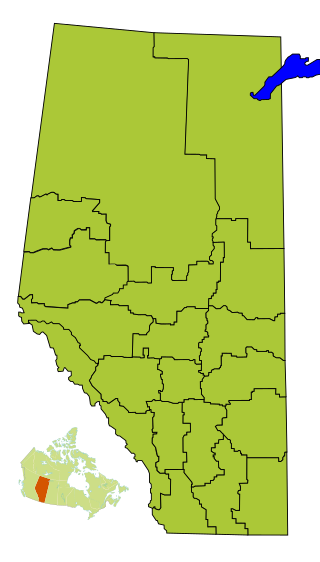
Division No. 11 is a census division in Alberta, Canada. Surrounding the City of Edmonton, the majority of the division comprises Alberta's Capital Region, while the western and southern portions of the division are located within central Alberta. The division also forms the northern segment of the Calgary–Edmonton Corridor.

The Edmonton Metropolitan Region (EMR), also commonly referred to as Greater Edmonton or Metro Edmonton, is a conglomeration of municipalities centred on Edmonton, the capital of the Canadian province of Alberta.
Calmar is a town in central Alberta, Canada. It is located in Leduc County, on Highway 39, 35 kilometres (22 mi) southwest from Edmonton. It was named in 1900 for Kalmar, Sweden, the home town of its first postmaster, C. J. Blomquist.
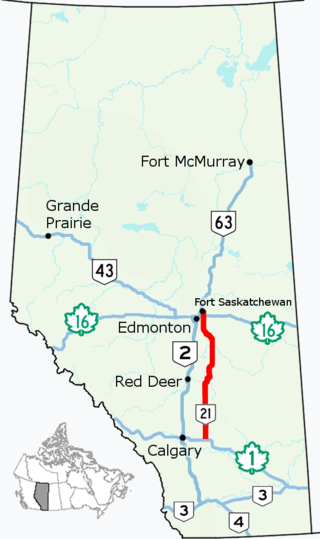
Alberta Provincial Highway No. 21, commonly referred to as Highway 21, is a north–south highway in Alberta, Canada that parallels Highway 2 between Calgary and Edmonton. It is approximately 328 kilometres (204 mi) in length. It begins at the Trans-Canada Highway (Highway 1) east of Strathmore, and ends at Fort Saskatchewan where it is succeeded by Highway 15. The northernmost 25 kilometres (16 mi) of the highway are twinned. Highway 21 runs roughly parallel to the main north–south CN rail line between Calgary and Edmonton between Three Hills and Looma.

Thorsby is a town in central Alberta, Canada. It is approximately 38 km (24 mi) west of the Leduc on Highway 39. Pigeon Lake and Pigeon Lake Provincial Park are located 20 km (12 mi) south of the community.
Warburg is a village in central Alberta, Canada. It is approximately 58 km (36 mi) west of Leduc on Highway 39. The village is named for Varberg Fortress in Sweden. The fortress's name was once spelled Warberg in English, but a spelling error resulted in the name Warburg.

Highway 19 and Highway 625 are two provincial highways south of Edmonton in the Canadian province of Alberta that form a continuous east–west route connecting Highway 60 near Devon to Highway 21 east of Beaumont. Highway 19 was acquired by the City of Edmonton in the land annexation approved by the Province in 2019. Highway 19 passes north of the Edmonton International Airport and, in tandem with Highway 60, provides a southwest bypass of Edmonton between Highways 2 and 16. East of Highway 2, Highway 19 becomes Highway 625 and continues through Nisku Industrial Park. It intersects Highway 814 in Beaumont before ending at Highway 21.

Alberta Provincial Highway No. 39, commonly referred to as Highway 39, is an east–west highway in central Alberta, Canada. It extends from Highway 22, approximately 13 kilometres (8 mi) east of Drayton Valley, to Leduc where it ends at Highway 2. Highway 39 is about 91 kilometres (57 mi) long.

Nisku is a hamlet and an industrial/business park in Alberta, Canada, within Leduc County. It has an elevation of 705 metres (2,313 ft).
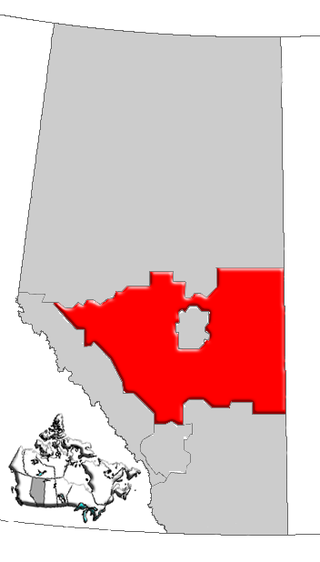
Central Alberta is a region located in the Canadian province of Alberta.
Port Alberta is a joint venture between Edmonton Global and Edmonton International Airport (EIA) based in the Edmonton Metropolitan Region in Alberta, Canada. Port Alberta provides transportation, logistics and supply chain solutions to connect Alberta's economy to worldwide markets. Its office is located in Edmonton.
The City of Edmonton has experienced a series of municipal boundary adjustments over its history since originally incorporating as a town in 1892 through incorporation as a city, amalgamation or annexation of other urban municipalities, annexation of rural lands from its surrounding neighbours, and separation of lands back to its rural neighbours. Its most recent annexations, which came into effect on January 1, 2019, involved acquisition of lands from predominantly Leduc County as well as Beaumont and Sturgeon County.
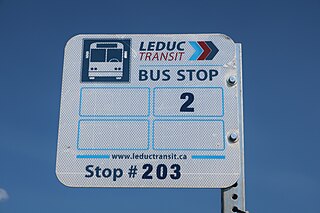
Leduc Transit is public bus system operated by the City of Leduc and Leduc County in the Edmonton Capital Region of Alberta, Canada. The service began on September 8, 2014. The capital investment was 5.16 million dollars CAD. GreenTRIP, a provincial fund to assist public transportation projects, has contributed 3.44 million dollars CAD. The remainder will be divided 65-35 between the City and the County respectively. In 2023, the system had a ridership of 111,900.











